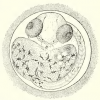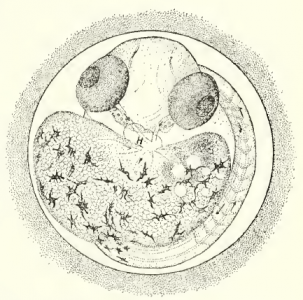Hypsoblennius hentz
Diagnosis
Diagnosis_Genus: Hypsoblennius Gill.
Blennius Linnaeus. Caput declive, tectum. Membr. branch. rad. VI. Corpus lanceolatum. Pinnae ventrales didactylae, muticae. Pinna ani distincta.
Diagnosis_Species: Blennius hentz Lesueur. A short fleshy appendage over each eye, and a small one over each nostril; teeth long, fine, equal, close set in the jaws; dorsal fin long, subequal, a little higher posteriorly. Body three inches and four lines long, including the caudal fin; one inch deep, and from six to seven lines thick, taken near the pectoral fins. Its form is little elongate, rather short; its thickest part is the nape; the front describes a curved line descending pretty rapidly to the end of the snout: back subrectilinear, descending gradually towards the base of the tail: abdomen ample, rounded: sides compressed: anus placed in the middle of the body: snout, although very short, not truncated vertically: eyes large, placed on the summit of the head, projecting a little, situated above the angle of the mouth: branchial opening placed anterior to the base of the pectoral fins, and extending from the base of these fins to the height of the eye; it is somewhat oblique: mouth small, nearly straight: lips not very thick: jaws equal, furnished with long and fine curved teeth, arranged like those of a comb: dorsal fin long, extending from the nape to the base of the caudal; its anterior part is lower, more equal, and sustained by eleven simple spinous rays; its colour is black, with some whitish spots; its posterior part is more elevated, rounded at the extremity and sustained by fourteen divided rays, of a reddish colour, with five blackish bands; in the middle it is slightly depressed, which admits of distinguishing the two parts: pectoral fins large, placed a little behind the origin of the dorsal fin: anal fin low, equal, reaching the base of the caudal: ventral fins of a blackish colour, with four or five light blackish bands, middle sized, placed before the line of the origin of the dorsal fin: caudal fin small, round, ornamented with three or four vertical bands; colour of the body light bluish-ash, mixed with rufous, with numerous and irregular black and rufous spots. D. 11, 14. A. 16. P. 16. J. 3. C. 18.
Body_male_length: 10 cm
Body_eggs_lenght: 0.72-0.80 mm (mean 0.77 mm)
Sequence_ENC1: KF678572 (Hundt & al. 2013)
Sequence_myh6: KF678666 (Hundt & al. 2013)
Sequence_ptr: KF678757 (Hundt & al. 2013)
Sequence_tbr1: KF678857 (Hundt & al. 2013)
Sequence_12sDNA: GQ865559, EU447257 (Javonillo & Harold 2010)
Etymology
Etymology: Hypsoblennius: Greek, hypsi = high + Greek, blennios = mucus.
Type species
The type species for the genus hypsoblennius is Blennius hentz (Lesueur, 1825).
Type illustration / Type locality / Type specimen
Type locality: Charleston, South Carolina, U.S.A.
Ecology
Habitat:Coastal
Habitat: This western Atlantic species is found along continental coasts from Nova Scotia, Canada south to St. Lucie Inlet, Florida and in the Gulf of Mexico from the Florida Keys to Port Isabel, Texas and Campeche Bay, Mexico (Williams 2002; McEachran and Fechhelm 2005). In the Gulf of Mexico, this species is distributed along the northern coast from Port Isabel, TX to the Florida Keys. This species prefers hard bottoms with shells, growths of plants, sponges, ascidians, and hydroids in the summer. In the winter, it is taken from deeper channels and holes (Smith-Vaniz 1980). It is reefassociated; inhabits oyster reefs and rocky shores. This species is also common in sea-grass flats (McEachran and Fechhelm 2005). It prefers a softer, muddy-bottomed habitat with higher salinities, but may be found on oyster reefs and grassflats.
Substrate: water
Salinity: marine
Depth: Epipelagic (0-20 m)
Temperature: 30°C
Oxygen_level: Oxic
Migratory: No
Life cycle
Reproduction_mode: sexual (oviparous) (distinct pairing)
Fertility_period: Seasonal (during spring and summer) (Spawning takes place between May and August on natural oyster reefs (Smith-Vaniz 1980; McEachran and Fechhelm 2005))
Sexual_dimorphism: The males appear to grow larger than the females (largest male at hand 104 and the largest female 84 mm long) and the males have a much longer tentacle over the eye.
Feeding behaviour
Mode of locomotion
Original description
Reference(s)
Attached phylogeny
Observation site(s)
SYMBIONTS
| Association with... | Region origin | Name of site | In reference... |
|---|---|---|---|
| Amyloodinium ocellatum | Gulf Coast Research Laboratory |
(1980) Studies on Amyloodinium ocellatum (Dinoflagellata) in Mississippi Sound: Natural and Experimental Hosts. Gulf Research Reports 6:403-413. |












































